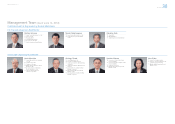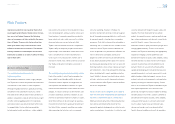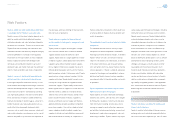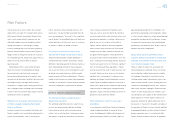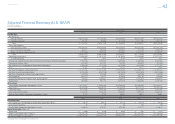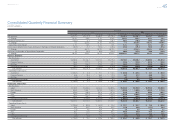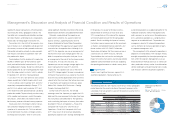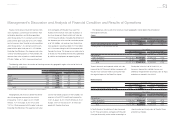Toyota 2013 Annual Report Download - page 47
Download and view the complete annual report
Please find page 47 of the 2013 Toyota annual report below. You can navigate through the pages in the report by either clicking on the pages listed below, or by using the keyword search tool below to find specific information within the annual report.
Toyota Global Vision President’s Message Launching a New Structure Special Feature Review of Operations
Consolidated Performance
Highlights
Management and
Corporate Information Investor InformationFinancial Section
Page 47
NextPrev
ContentsSearchPrint
ANNUAL REPORT 2013
Changes in laws, regulations, policies and other
governmental actions can also materially impact the
profi tability of Toyota’s automotive operations.
These laws, regulations and policies include those
attributed to environmental matters, vehicle safety,
fuel economy and emissions that can add signifi -
cantly to the cost of vehicles. The European Union
has enforced a directive that requires manufacturers
to be fi nancially responsible for taking back end-of-
life vehicles and to take measures to ensure that
adequate used vehicle disposal facilities are estab-
lished and those hazardous materials and recycla-
ble parts are removed from vehicles prior to
scrapping. See “Legislation Regarding End-of-Life
Vehicles”, “Information on the Company—Business
Overview—Governmental Regulation,
Environmental and Safety Standards” in Toyota’s
annual report on Form 20-F and note 23 to the con-
solidated fi nancial statements for a more detailed
discussion of these laws, regulations and policies.
Many governments also regulate local content,
impose tariffs and other trade barriers, and enact
price or exchange controls that can limit an auto-
maker’s operations and can make the repatriation of
profi ts unpredictable. Changes in these laws, regu-
lations, policies and other governmental actions
may affect the production, licensing, distribution or
sale of Toyota’s products, cost of products or appli-
cable tax rates. From time-to-time when potential
safety problems arise, Toyota issues vehicle recalls
and takes other safety measures including safety
campaigns with respect to its vehicles. In November
trend in the automotive markets. As competition
increases, margins on fi nancing transactions may
decrease and market share may also decline as
customers obtain fi nancing for Toyota vehicles from
alternative sources.
Toyota’s fi nancial services operations mainly
include loans and leasing programs for customers
and dealers. Toyota believes that its ability to pro-
vide fi nancing to its customers is an important value
added service. Therefore, Toyota has expanded its
network of fi nance subsidiaries in order to offer
fi nancial services in many countries.
Toyota’s competitors for retail fi nancing and retail
leasing include commercial banks, credit unions
and other fi nance companies. Meanwhile, commer-
cial banks and other captive automobile fi nance
companies also compete against Toyota’s whole-
sale fi nancing activities.
Toyota’s total fi nance receivables increased dur-
ing fi scal 2013 mainly due to the favorable impact of
fl uctuations in foreign currency translation rates and
an increase in the retail receivables.
2009, Toyota announced a safety campaign in
North America for certain models of Toyota and
Lexus brands’ vehicles related to fl oor mat entrap-
ment of accelerator pedals, and later expanded it to
include additional models. In January 2010, Toyota
announced a recall in North America for certain
models of Toyota vehicles related to sticking and
slow-to-return accelerator pedals. Also in January
2010, Toyota recalled in Europe and China certain
models of Toyota vehicles related to sticking accel-
erator pedals. In February 2010, Toyota announced
a recall in markets including Japan, North America
and Europe related to the braking control system in
certain vehicle models including the Prius. The
recalls and other safety measures described above
have led to a number of claims, lawsuits and gov-
ernment investigations against Toyota in the United
States. For a more detailed description of these
claims, lawsuits and government investigations, see
note 23 to the consolidated fi nancial statements.
The worldwide automotive industry is in a period
of global competition which may continue for the
foreseeable future, and in general the competitive
environment in which Toyota operates is likely to
intensify. Toyota believes it has the resources, strat-
egies and technologies in place to compete effec-
tively in the industry as an independent company for
the foreseeable future.
Financial Services Operations
The competition of worldwide automobile fi nancial
services industry is intensifying despite the recovery
Management’s Discussion and Analysis of Financial Condition and Results of Operations
20,000
0
15,000
10,000
5,000
FY
Total Assets by Financial Services Operations
(¥ Billion)
’09 ’10 ’11 ’12 ’13
Selected Financial Summary (U.S. GAAP) Consolidated Segment Information Consolidated Quarterly Financial Summary Management’s Discussion and Analysis of Financial Condition and Results of Operations [2 of 26] Consolidated Financial Statements Notes to Consolidated Financial Statements
Management’s Annual Report on Internal Control over Financial Reporting Report of Independent Registered Public Accounting Firm



